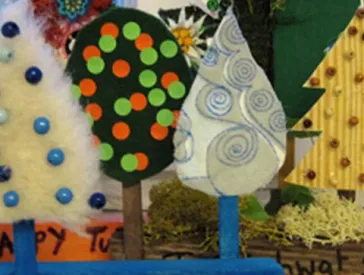Tu bi-Shevat
On Tu bi-Shevat, Jews celebrate the New Year of the trees. Shevat is a month in the Hebrew calendar that generally coincides with January/February in the Gregorian calendar. The letters Tet (9) and Vav (6), which together are pronounced and transliterated as “Tu,” add up to 15 in the Hebrew system of representing numbers using letters. So “Tu bi-Shevat” is simply the date of the holiday, the 15th of Shevat. This time, in Israel and the greater Mediterannean region, is roughly when trees begin to bloom.
The Seven Species
Celebrating Tu bi-Shevat means eating plenty of fruit and grain, especially the seven species that the Torah promises will be abundant in the Holy Land: wheat, barley, grapes, figs, pomegranates, olives, and dates.
For the LORD your God is bringing you into a good land, a land with streams and springs and fountains issuing from plain and hill; a land of wheat and barley, of vines, figs, and pomegranates, a land of olive trees and honey ... When you have eaten your fill, give thanks to the LORD your God for the good land which He has given you. Take care lest you forget the LORD your God and fail to keep His commandments, His rules, and His laws, which I enjoin upon you today. (Deuteronomy 8:7–11)
There is also a custom to eat carob on Tu bi-Shevat and another custom to taste a fruit that you have not eaten yet this year (since Rosh ha-Shanah). A further custom from the Diaspora is to assemble fifteen fruits that serve as a reminder of the Land of Israel. With a blessing over the fruit, Jews thank God as the creator of fruit from trees.
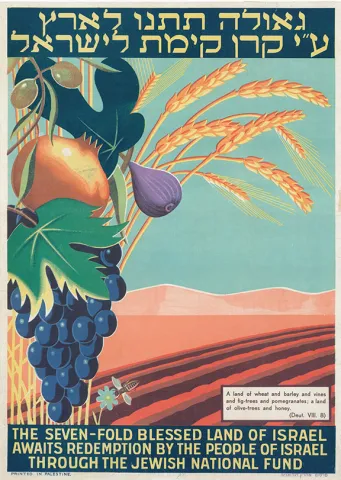
Poster of the Jewish National Fund; Central Zionist Archives, Jerusalem, notation: KRA\72
 X
X
Poster of the Jewish National Fund; Central Zionist Archives, Jerusalem, notation: KRA\72
The New Year of the Trees
Although early sources do not assign a special role to Tu bi-Shevat, it was elevated to the status of a holiday over time. Designating a specific day as the “New Year of the Trees” made following certain biblical rules easier. For example, it is forbidden to eat the fruit of a tree that is younger than three years old; this gives young trees time to grow and flourish in peace (see Leviticus 19:23). Also, during certain years of a seven-year cycle, a tenth of all harvested fruit was taken to Jerusalem and eaten there. Whether a tree blossoms before or after Tu bi-Shevat determines which year its harvest falls in.
One of the first trees to blooms in Israel is the almond tree. It is the subject of the well-known Tu bi-Shevat song Hashkediya Porachat, which is sung on the New Year of the Trees.
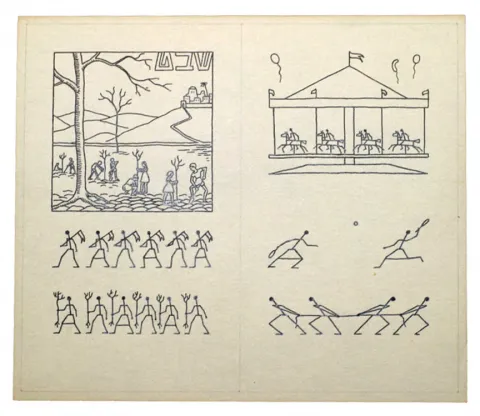
Ink drawing by Hermann Fechenbach (1897–1986) for the month of Shevat from a series of images he made for the months of the Jewish calendar and for Jewish holidays, about 1936–41; Jewish Museum Berlin, accession 2008/140/23, Copyright 2017 Patrick Mooney/Geoffrey Burne. Further information on this drawing can be found in our online collections (in German)
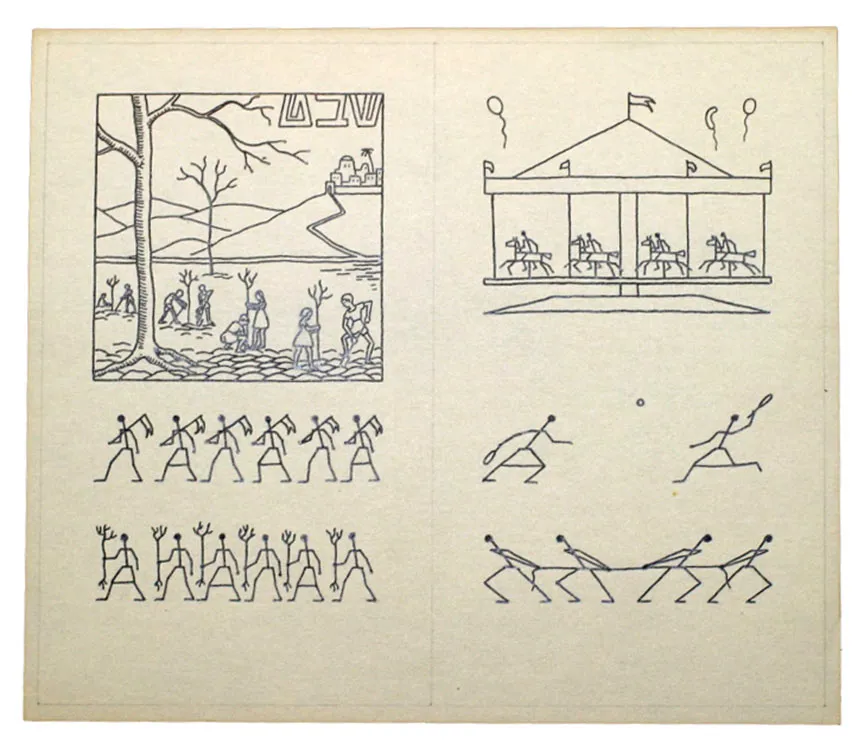 X
X
Ink drawing by Hermann Fechenbach (1897–1986) for the month of Shevat from a series of images he made for the months of the Jewish calendar and for Jewish holidays, about 1936–41; Jewish Museum Berlin, accession 2008/140/23, Copyright 2017 Patrick Mooney/Geoffrey Burne. Further information on this drawing can be found in our online collections (in German)
Tu bi-Shevat Song: “The Almond Tree is Growing”
The almond tree is growing,
A golden sun is glowing;
Birds sing out in joyous glee
From every roof and every tree.Tu BiShvat is here,
The Jewish Arbor Day
Hail the trees' New Year,
Happy holiday!
The original Hebrew version of this song is called Hashkediya Porachat. The author of this English adaptation is unknown. Here, the original Hebrew version:
,הַשְּׁקֵדִיָּה פּוֹרַחַת
.וְשֶׁמֶשׁ פָּז זוֹרַחַת
צִפֳּרִים מֵרֹאשׁ כָּל גַּג
:מְבַשְּׂרוֹת אֶת בּוֹא הֶחָג
ט”וּ בִּשְׁבָט הִגִּיעַ
!חַג הָאִילָנוֹת
ט”וּ בִּשְׁבָט הִגִּיעַ
!חַג הָאִילָנוֹת
Are Trees Human?
These days, Tu bi-Shevat is primarily a festival of gratitude for the harmonious relationship between God, humanity, and nature. In Israel, schoolchildren often take field trips to plant trees on the holiday.
In both Israel and the Diaspora, there is a custom of holding a Tu bi-Shevat seder. Some Jewish communities and organizations invite their members to a Tu bi-Shevat seder to eat, drink, sing, and read the Tu bi-Shevat Haggadah. (More detailed information about the Tu bi-Shevat seder on our website.)
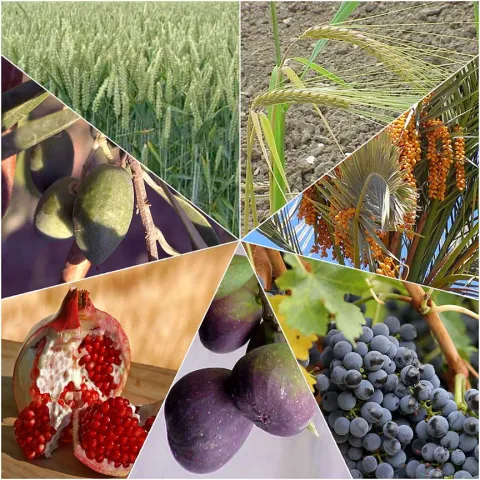
The Seven Species; photo: רוליג; using footage of Bernadette Simpson, Rodrigo Nuno Bragança da Cunha, Fir0002/ Flagstaffotos, and Kurt Stueber, CC BY-SA 4.0, via Wikimedia Commons
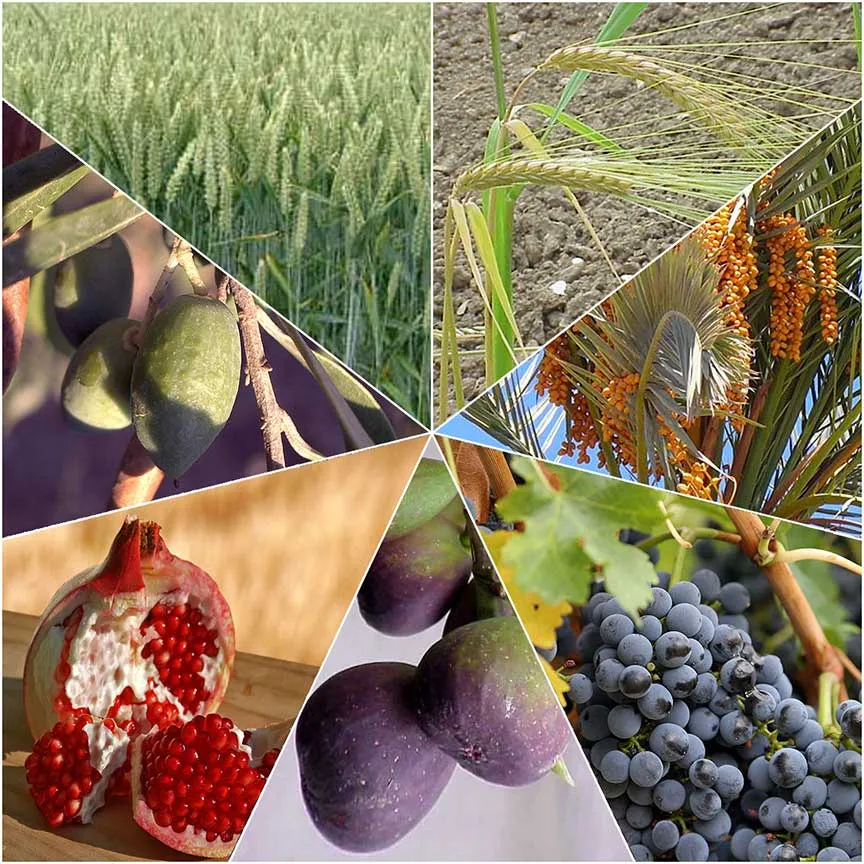 X
X
The Seven Species; photo: רוליג; using footage of Bernadette Simpson, Rodrigo Nuno Bragança da Cunha, Fir0002/ Flagstaffotos, and Kurt Stueber, CC BY-SA 4.0, via Wikimedia Commons
When in your war against a city you have to besiege it a long time in order to capture it, you must not destroy its trees, wielding the ax against them. You may eat of them, but you must not cut them down. Are trees of the field human to withdraw before you into the besieged city? (Deuteronomy 20:19)
On Tu bi-Shevat, this biblical analogy between trees and humans invites us to think about what trees mean for humanity. For example, they must develop strong roots in order to bear plentiful fruits.
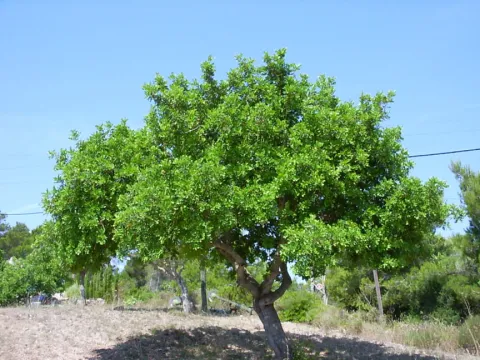
Carob tree; photo: Pedro Servera, CC BY-SA 3.0, via Wikimedia Commons
 X
X
Carob tree; photo: Pedro Servera, CC BY-SA 3.0, via Wikimedia Commons
Choni and the Carob Tree: A Thematic Story from the Babylonian Talmud
One day, Choni HaMe’aggel was walking along the road when he saw a certain man planting a carob tree.
Choni said to him: “This tree, after how many years will it bear fruit?”
The man said to him: “It will not produce fruit until seventy years have passed.”
Choni said to him: “Is it obvious to you that you will live seventy years, that you expect to benefit from this tree?” He said to him: “That man himself found a world full of carob trees. Just as my ancestors planted for me, I too am planting for my descendants.”
Choni sat and ate bread. Sleep overcame him and he slept. … When he awoke, he saw a certain man gathering carobs from that tree. Choni said to him: “Are you the one who planted this tree?” The man said to him: “I am his son’s son.” Choni said to him: “I can learn from this that I have slept for seventy years.”
(Babylonian Talmud, Taanit 22b–23a)


